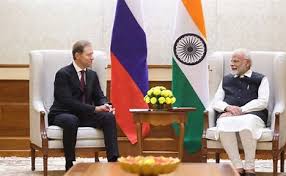 KATHMANDU: It’s time to make a new beginning in South Asia and convert cynicism and skepticism shadowing the SAARC grouping into a ripe field of opportunity through deeper integration and freer movement of goods, people and dreams. This was the overarching message of India’s Prime Minister Narendra Modi’s debut speech at the SAARC summit in the Nepali capital as he unveiled new unilateral initiatives in areas of education, business, public health and IT, and offered to launch a SAARC satellite by 2016.
KATHMANDU: It’s time to make a new beginning in South Asia and convert cynicism and skepticism shadowing the SAARC grouping into a ripe field of opportunity through deeper integration and freer movement of goods, people and dreams. This was the overarching message of India’s Prime Minister Narendra Modi’s debut speech at the SAARC summit in the Nepali capital as he unveiled new unilateral initiatives in areas of education, business, public health and IT, and offered to launch a SAARC satellite by 2016.
The prime minister spelt out the five pillars that underpin India’s vision for the region, which includes trade, investment, assistance, cooperation in every area, contacts between people – and, all through seamless connectivity.
In his speech, Mr Modi, who is attending a SAARC summit for the first time, provided a trenchant prognosis of what ails the eight-nation South Asian Association for Regional Cooperation, and exhorted the SAARC leader to convert cynicism into a new narrative of hope and opportunity to bind the region together in an intimate mesh of trading, rail, road and air links.
Behind SAARC scepticism
“When we speak of SAARC, we usually hear two reactions – cynicism and scepticism. This, sadly, is in a region throbbing with the optimism of our youth,” Mr Modi told the leaders of the SAARC countries at the City Hall, festively decorated with SAARC banners, in the heart of Kathmandu.
He highlighted the region’s record of woefully inadequate integration amid a “rising tide of integration” across the world, which he saw first-hand during his travels in the last six months “from the middle of the Pacific, to the southern coast of Atlantic Ocean.”
“Today, less than 5% of the region’s global trade takes place between us. Even at this modest level, less than 10% of the region’s internal trade takes place under SAARC Free Trade Area. Indian companies are investing billions abroad, but less than 1% flow into our region.”
“I have great belief in our boundless potential; and, confidence – that comes from the many inspiring stories of innovation and initiative in each of our countries,” said the prime minister, an eternal optimist who made a strong pitch for infusing a new energy and vitality into a regional grouping that even after 29 years remains mired in apathy, differences and mutual suspicion among member countries.
Identifying the lack of adequate implementation and follow-up actions as the core problem that bedevils the SAARC, the leader of the world’s largest democracy reminded the leaders that while India has done bilateral connectivity and energy deals with Nepal, Bangladesh, Bhutan and Afghanistan, “as SAARC we have failed to move with the speed that our people expect and want.”
“Some argue that it is because of the region’s development gap. But, that should actually spur us to do more. Or, is it because we are stuck behind the walls of our differences and hesitant to move out of the shadows of the past?”
It’s economics, stupid!
 The reform-minded Indian prime minister, who has garnered a growing constituency for his business-friendly policies, made a strong pitch for enhancing intra-regional trade and investment. “We must shrink the distance between our producers and consumers and use the most direct routes of trade. I know India has to lead, and we will do our part.I hope, each of you will, too.” Stressing that infrastructure is our region’s greatest weakness and it’s most pressing need, he announced the setting up of a special purpose vehicle to finance infrastructure in the region and unveiled his plan to offer business visas for three to five years to businessmen from SAARC countries.
The reform-minded Indian prime minister, who has garnered a growing constituency for his business-friendly policies, made a strong pitch for enhancing intra-regional trade and investment. “We must shrink the distance between our producers and consumers and use the most direct routes of trade. I know India has to lead, and we will do our part.I hope, each of you will, too.” Stressing that infrastructure is our region’s greatest weakness and it’s most pressing need, he announced the setting up of a special purpose vehicle to finance infrastructure in the region and unveiled his plan to offer business visas for three to five years to businessmen from SAARC countries.
Making SAARC people-centric: Health and education
In the area of public health, he announced the setting up of the SAARC Regional Supra Reference Laboratory for TB and HIV and offerd the five-in-one vaccine for the children of South Asia. He also promised to provide immediate medical visas to those wishing to come to India for treatment. “We will support monitoring and surveillance of polio-free countries, and provide vaccines where it might reappear,” he said.
Projecting education as the bridge to prosperity in the region, the prime minister announced that India is “prepared to connect South Asian students through online course and E-libraries.” “When we set up India’s National Knowledge Network, we will be happy to extend it to the SAARC region,” he said.
SAARC Satellite: Soaring Hopes
Seeking to pitch the SAARC into a higher orbit, Mr Modi announced India’s gift of a satellite for the SAARC region and underlined that it will benefit South Asia in areas like education, telemedicine, disaster response, resource management, weather forecasting and communication. “And, we plan to launch our satellite by the SAARC Day in 2016.” India will also host a conference to strengthen the region’s collective ability to apply space technology in economic development and governance.
Combating Terror
While conjuring up a radiant vision for the future of the region, the Indian prime minister stressed that a prosperous SAARC needs the strong foundation of a secure South Asia and reminded the region of the need for renewing the pledge to combat terrorism and trans-national crimes. Alluding to the horror of the terror attack in Mumbai in 2008, Mr Modi said: “If we are sensitive to each other’s security, and the lives of our people, we will deepen friendships, spur cooperation and advance stability in our region. “
A Himalayan Call: It’s time to act
Mr Modi ended his debut SAARC pitch on a high note, invoking the majestic Himalayas to exhort the leaders to the region to dream big and make it real.
“There is a new awakening in South Asia; a new recognition of inter-linked destinies; and, a new belief in shared opportunities. We are meeting in the lap of Himalaya, which has nurtured us through the ages. Today, it is calling us to act.”
“Let us work to change cynicism into optimism. Let us turn South Asia of flowering hope into a rich field of peace and prosperity.”
Reality Check
For all the grand-sounding words and declarations by Mr Modi and other leaders , it looks like the SAARC dream of regional integration is again stalled due to the festering rivalry and posturing between India and Pakistan. The two expected showpiece outcomes – a pan-regional motor vehicles agreement and energy-cooperation framework pact – have been scuppered, with Islamabad showing diffidence to sign on the dotted lines ostensibly on grounds that the country has to first go through its internal processes. Bridging the gap between talk and action, the eternal affliction of SAARC, is not going to be easy, and for all Mr Modi’s bid to convert sceptics, the failure to seal these agreeements which would have pushed the three C agenda– Culture, Commerce and Creativity — is only going to embolden sceptics.
Author Profile

- Manish Chand is Founder and Editor-in-Chief of India Writes Network (www.indiawrites.org) and India and World, a pioneering magazine focused on international affairs. He is CEO, Centre for Global India Insights, an India-based think tank focused on global affairs.
Latest entries
 India and the WorldOctober 27, 2025Modi hails the century of India and ASEAN, backs ASEAN centrality
India and the WorldOctober 27, 2025Modi hails the century of India and ASEAN, backs ASEAN centrality India and the WorldOctober 26, 2025Act East: Five reasons why ASEAN summit in Malaysia matters
India and the WorldOctober 26, 2025Act East: Five reasons why ASEAN summit in Malaysia matters India and the WorldOctober 25, 2025Malaysia Summit: India can play a bigger role in ASEAN: Anil Wadhwa
India and the WorldOctober 25, 2025Malaysia Summit: India can play a bigger role in ASEAN: Anil Wadhwa India and the WorldOctober 2, 2025With US frowning, India to host Putin in December
India and the WorldOctober 2, 2025With US frowning, India to host Putin in December







